On Tuesday arvo I made a foray down into the third floor exhibition space, which is full of building materials, tools and preparators working hard to get the galleries ready for the exhibition.
Since there’s only a week and a bit to go before the opening, I guess I wanted to hear from the folks who set things up. How do they feel about the processes and wastes that surround their jobs?
Here’s Jay. He’s been working for the MCA for over a decade – originally as an employee, and now as an external contractor who comes in to custom-build walls for specific exhibitions.
What I like about this photo (besides Jay’s cheeky glance, and his precious bike parked in the background) is that it shows the wall he has built at what I think is its most beautiful moment.
Jay is in the process of applying “mud” – a kind of bulk plaster-spakfiller used to smooth the gaps between the sheets of chipboard which make up the wall, rendering it flawlessly smooth.
Once this “mud” has been sanded back, and it’s had two or three coats of white paint applied to it, the wall effectively disappears. But right now, the wall reveals its labour, its craft. Its pure rectilinearity can be tangibly appreciated as a direct result of human ingenuity and skill.
Aesthetically, it’s a satisfying object in its own right.
But this moment is fleeting. The eventual invisibility of these custom-walls is, in a way, one of the MCA’s great claims to fame. The museum “creates spaces” to best house the artworks which are in each show. And I know from experience (as I too, like Jay, have spent some years installing art here) that the artists whose works are exhibited in these spaces are very appreciative of the attention which is bestowed on “getting it right”.
But how much chipboard, aluminium stud and track, pine two-by-four, mud, undercoat and topcoat paint is used in “getting it right”? And is it worth it?
I put this to Jay. His response was that if the MCA stopped building custom walls, he’d have no work to do. So obviously that’s a consideration – building walls creates opportunities for labour, especially for artists. (Many of the prep crew at the MCA are – like Jay – practicing artists themselves).
But on reflection, he said, he gets plenty of other work around town, so that’s not really the main issue.
Is it worth it? Nah, he didn’t really think so. But then, Jay said, he was a bad person to ask, since he can’t stand a whole heap of the art he sees, regardless of whether or not it’s had special walls built for it. At this point we both lapsed into a discussion about how beautiful his wall was, as well as other things: his young son and his partner Liz, his bicycle, surfing; all of which, if I’m not mistaken, matter to Jay more than the art which gets hung on the walls he builds.
I should note that this precise moment, when I witnessed Jay’s unfinished wall, allows you to easily identify some of its constituent parts. See all the white panels at the left in the photo above? Those are re-used panels from the previous show in the MCA (the Sydney Biennale). Only the brown one closer to Jay is a new panel.
And if you look closely at this photo below (where Jay’s mudding crony, Stephen, quickly tries to escape the frame) you might just see some of the scratchy substrate under the white paint:
And here’s a close up so you can see it more clearly:
Those scratchy lines are the remnant of an artwork, directly drawn on the wall, by artist Kim Jones, exhibited in the Sydney Biennale. (Coincidentally, Kim, in his performance art alter-ego, according to the ever reliable wikipedia, was during the 1960s known as “The Mudman”. But that’s beside the point.) The point is this: the MCA recycles wall-building materials, whenever it is practically possible.

Tony, the boss of the installation team, last week showed me a stack of wall panels which had been queued up ready to be re-purposed for the coming show. Here they are (and there’s Tony in the background, talking logistics with Isabel the indefatigable curatorial assistant):
Tony says, with a deep sigh, that the noble quest to re-use chipboard wall sheets is “entropy in action“. Each time you re-use a sheet, you have to do more work than before, to make it fit, to sand and remove all the old screws, to repaint it smooth (or in the case of Kim Jones’ graphite scribble drawing above, to apply a sealant so that the carbon doesn’t continue to rise through the layers of white paint over the top of it).
And of course, the sheets get smaller and smaller as bits get trimmed off, until they’re completely unusable for the purpose of wall-building – at which point they either get thrown into the skip or taken home by one of the enterprising preparators to be given a new life, as something else.
To put it in perspective, here’s two drawings showing the previous show (the Biennale) and the upcoming show, with new walls to be built coloured in red:
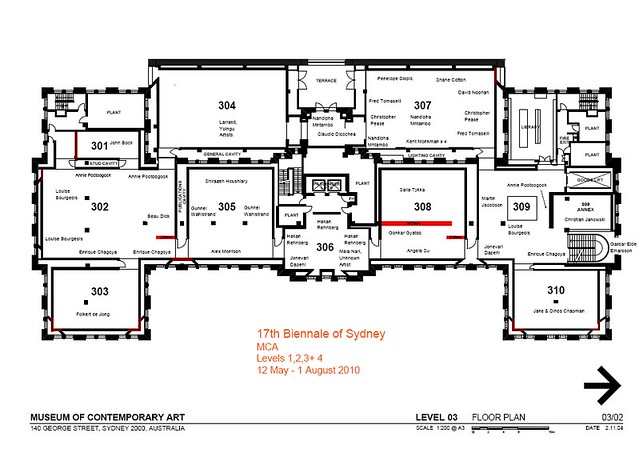
[above: Sydney Biennale wall-building plan]
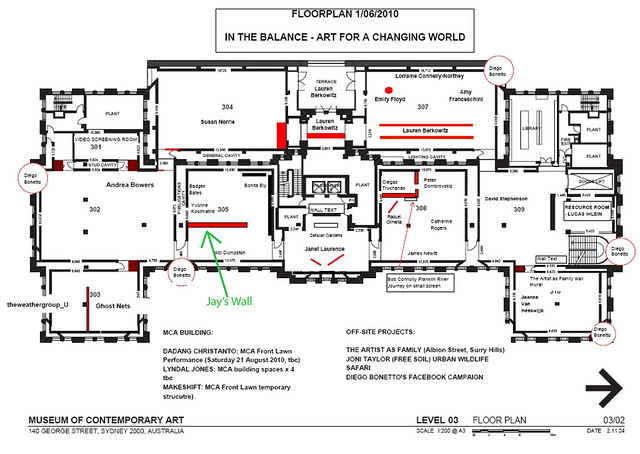
[above: In the Balance wall-building plan. Note that the walls to be built are the red bits with the thin black lines around ’em]
Now, this might not seem like very much, in the way of wall building – but the materials used for a six metre stretch of wall – such as the one Jay is building in the photo above – are not insignificant. About fourteen sheets are used for Jay’s wall, plus an interior skeleton of pine “two-by-four”, plus about 20 or 30 screws for each sheet, not to mention the mud, and then the paint to make the whole thing seem like it was always there to begin with.
(Now that I’ve started this line of enquiry, I’m going to ask the ever co-operative Tony to help me get these figures more accurate, so we can work out the total volume of wallbuilding materials the MCA uses over an average year).

As I continued on my wander around the galleries, I bumped into another preparator. This fellow had some pretty strong views on the MCA’s use of materials and production of waste. He was a bit nervous to go “on the record”, and so to facilitate speaking freely, he asked to remain anonymous. Let’s call him “Hank” for now.
“Man, you should have been here last week when we were pulling out walls!” Hank exclaimed. “There is so much waste after every show. We’ve filled a couple of skips already with rubble from the Biennale. And we’re supposed to be setting up a show about sustainability? It’s just environmental hypocracy!”
In fact, I was here last week – when I took this photo below:
Quite a beautiful disarray, within the formlessness tradition of scatter-sculpture (in this case, unauthored, of course).
For Hank, though, this behind the scenes trash, in the name of art is horrific. “Man, if I was an artist in the In the Balance exhibition, you know what my piece would be? I’d just ask ’em to leave a room aside for me, and get the preps to throw into that room all the building materials from the previous exhibition which were heading for the skip. And that would be my piece”.
And quite a stunning piece it’d be – creating a strong visual impact, institutional-critique style glimpse into the material operations of the art world.
Damn, wish I’d thought of it myself.
I asked Hank how he felt, working in what he sees as an inherently wasteful workplace.
“Depressing, man, it’s just depressing. I reckon artists should just have to adapt themselves to the existing space, and if they can’t do it, well, it just means they’re not good enough at what they do”.
Our conversation ranged over a whole lot of things – from folks who recycle their plastic bottles and thus feel like they have a get-out-of-jail-free card to drive their 4WDs around the city, to the ever-increasing demands for “professional-looking” results in the setting up of art (especially video art).
For Hank, if we eradicated the wall-building component of MCA exhibitions, this alone would save thousands of dollars and free up a few extra months each year, so that more artists could be included in the exhibition programme (on average, it takes 2-3 or so weeks to change over between shows at the museum).
But the MCA’s presentation standards are tied into a whole international network of expectations, and a whole funding stream which supports its current practices. In essence, Hank is talking about a totally different model of gallery – one with less technical support, where artists are independently resourceful, where they work with the existing space rather than demanding it be wiped clean and transformed for them at whim.

As I ambled around the gallery, I found myself visiting what is to be the “resource room”, where my own work will be set up. Yes, even I, your humble Environmental Auditor, am guilty of demanding the space be transformed at my whim. Last week, it occurred to me that it’d be good to have my space coated with blackboard paint.
Because of the way that the MCA works, I know that I wont have to do the painting myself. I know that I won’t have to go to the hardware store to buy it, and I know I won’t have to wash up the brushes afterwards. Best of all, I know I won’t have to paint it out after the show comes down (not an easy task with blackboard paint). Hell, I don’t even have the foggiest idea how much all these things are going to cost (materials plus labour). There’s a kind of “magic” that happens when you exhibit in this place. It’s exhilarating, it’s terrifying.
So. Here are Garth and Belinda, cheerfully painting “my” resource room with white undercoat:
Cheerful, that is, until I informed them that the next step is for the walls to be coated with blackboard paint. This struck them as very odd. The paint underneath the white had been a dark blue-grey. Couldn’t the blackboard paint just be applied directly over the top of it?
…and so off they went to double check with the boss, to find out whether what they were doing was a waste of time, not to mention materials.
As Garth said, trying to be diplomatic: “Painting walls white is a bit zen – you have to ‘get into the zone’ or you can go totally nuts. But if you find out what you’re doing is futile… if you know it’s just going to be painted over again…well…”
I could see the steam beginning to come out of his ears. I slinked off, wondering whether my blackboard whim was a good idea (“aesthetically” speaking) after all.

[postscript: thinking about paint opens up a whole world of worry. From memory, the MCA has some good practices in place for cleaning and disposing of paint, so that it doesn’t all just run down the drains to the stormwater system and out into the sea. I’ll try to look into these in more detail soon…]

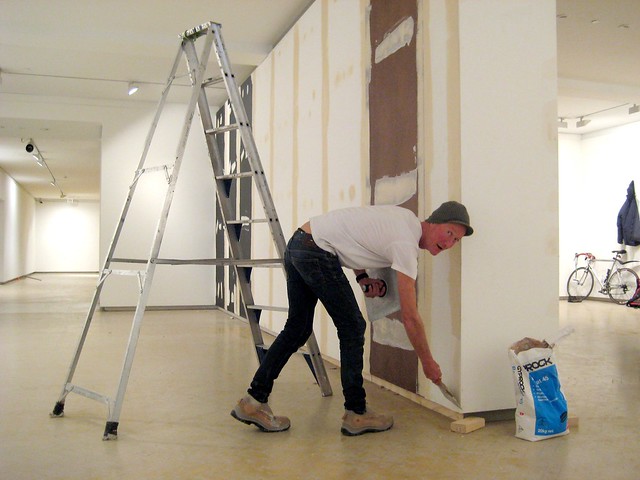
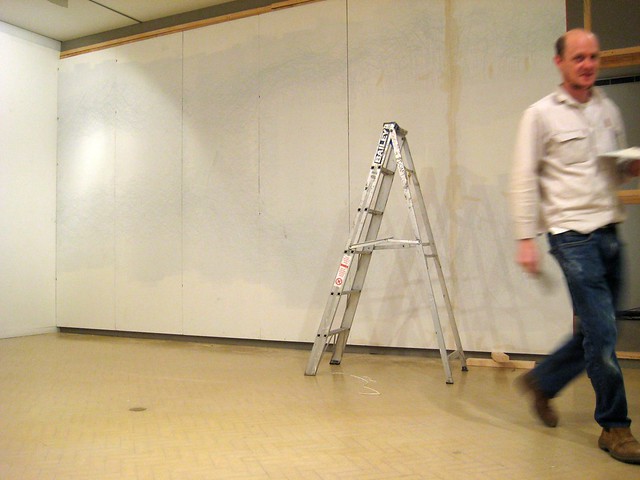
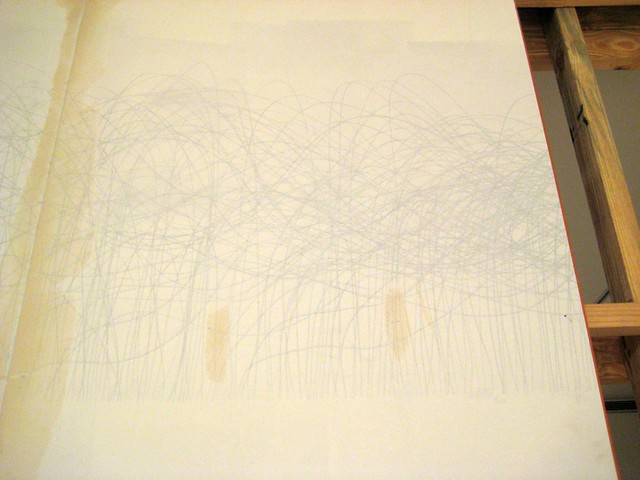
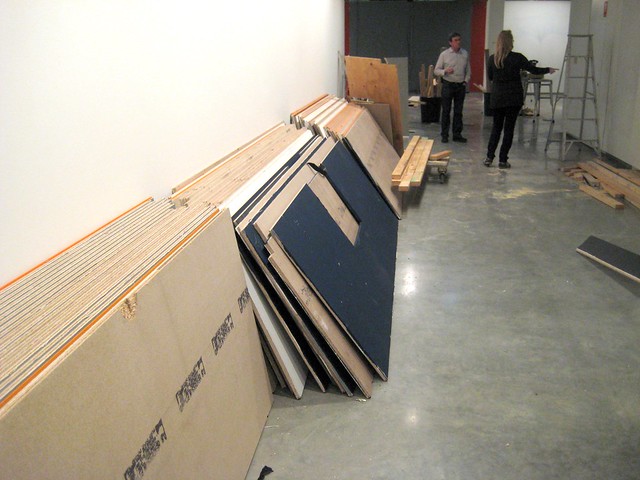
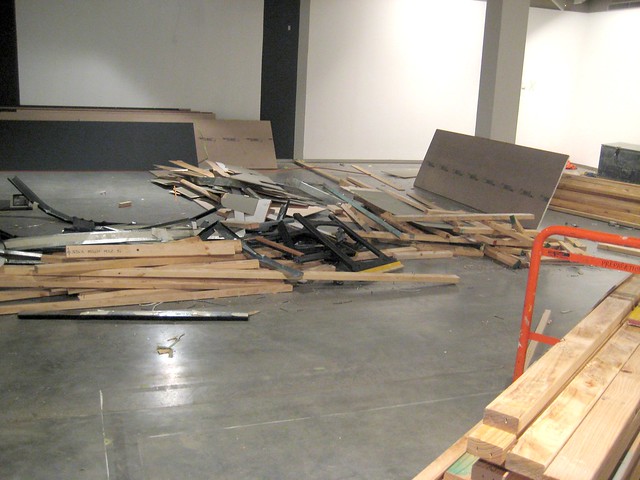
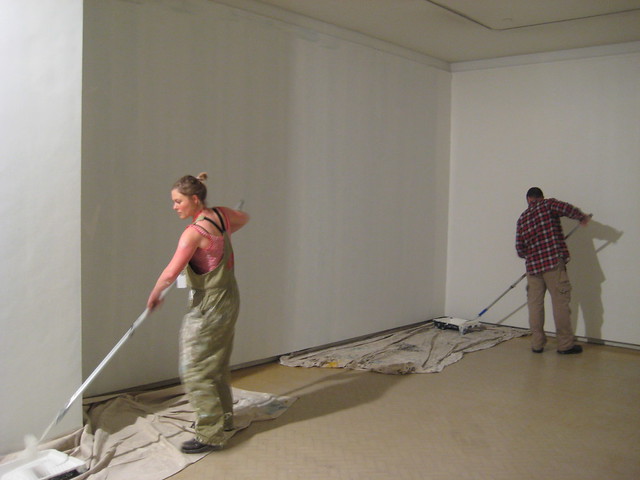
Ralph and Jay rock!!!!!!
The irony of all this is that Jay and Stephen are probably the best artists I know.
I have an empty tin of paint i’d like to give you to place in your room.
sounds good mikey. is it the blackboard paint?
The hypocrisy link is great, nails that whole issue.
And can I assume by now everyone has read “Cradle to Cradle:remaking the way we make things’ by William McDonough, and Michael Braungart that argues for a design revolution in which all products and material are designed and manufactured to be almost infinitely reused. One of the points they make is that it is simpy more economic to create recyclable materials, no doubt one of the reasons the MCA reuses wall board. Human labour is also costly but it doesn’t generate CO2. And you haven’t even touched on the area of natural and low VOC paints, a little controversy that mostly misses the point that the first issue in every debate should be energy intensity over the entire life cycle of the product with most other issues other than immediate toxicity having lower priority.
And I just noticed your links for people who aren’t in the exhibition (should have been in the exhibition?) How about Ash Keating?
thanks Ian, yes, i think many of the labels on paint tins display their “green credentials” mainly based around the idea that they don’t release as many toxic gases when used – rather than talking about their manufacturing and disposal processes over – as you say – the entire life cycle of the paint.
I haven’t read that book you mention, but it does sound like I’m heading in that direction, so I’ll look it up. Phew, I’ve got a lotta homework to do. I need an assistant!
I’ve put up a link for Ash Keating now, good tip. His own website doesn’t have much on it but if you google him, you find some interesting stuff. I remember Ash telling me a few years ago that he actually works as a waste auditor consulting with corporations. I shall track him down and ask him about that…
update – Tony responds to wall-building and other issues here.